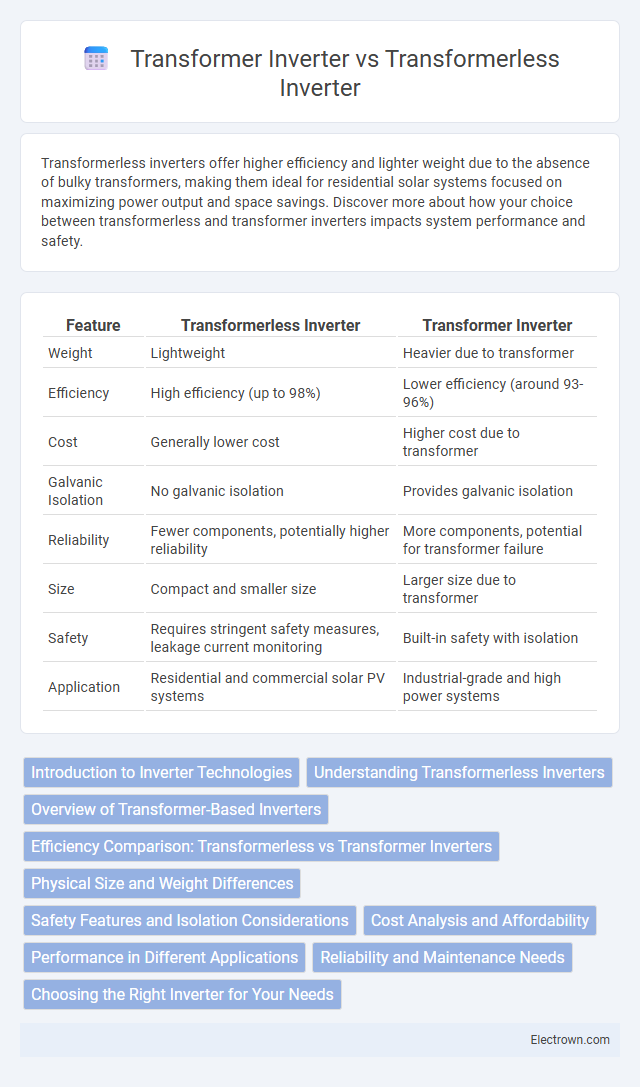Transformerless inverters offer higher efficiency and lighter weight due to the absence of bulky transformers, making them ideal for residential solar systems focused on maximizing power output and space savings. Discover more about how your choice between transformerless and transformer inverters impacts system performance and safety.
Table of Comparison
| Feature | Transformerless Inverter | Transformer Inverter |
|---|---|---|
| Weight | Lightweight | Heavier due to transformer |
| Efficiency | High efficiency (up to 98%) | Lower efficiency (around 93-96%) |
| Cost | Generally lower cost | Higher cost due to transformer |
| Galvanic Isolation | No galvanic isolation | Provides galvanic isolation |
| Reliability | Fewer components, potentially higher reliability | More components, potential for transformer failure |
| Size | Compact and smaller size | Larger size due to transformer |
| Safety | Requires stringent safety measures, leakage current monitoring | Built-in safety with isolation |
| Application | Residential and commercial solar PV systems | Industrial-grade and high power systems |
Introduction to Inverter Technologies
Transformerless inverters maximize efficiency by eliminating bulky transformers, reducing energy losses and improving power output in photovoltaic systems. Transformer inverters incorporate magnetic transformers to provide galvanic isolation, enhancing safety and compatibility with electrical grids but at the cost of increased weight and reduced efficiency. The choice between these technologies depends on system requirements, including installation size, budget, and safety regulations.
Understanding Transformerless Inverters
Transformerless inverters improve energy efficiency by eliminating bulky transformers, reducing weight and size in solar power systems. They offer higher conversion efficiency, typically exceeding 98%, by minimizing energy losses associated with magnetic components. These inverters require advanced safety features like galvanic isolation through monitoring and grounding techniques to ensure user protection and system reliability.
Overview of Transformer-Based Inverters
Transformer-based inverters utilize electromagnetic transformers to step up or step down voltage, providing galvanic isolation and enhanced safety in power conversion systems. These inverters typically offer robust voltage regulation and protection against surges, making them suitable for applications requiring stable output and isolated power sources. Your choice of a transformer inverter ensures reliable energy conversion for sensitive equipment, albeit with increased size and weight compared to transformerless models.
Efficiency Comparison: Transformerless vs Transformer Inverters
Transformerless inverters typically offer higher efficiency, often exceeding 98%, due to reduced energy loss associated with the absence of a bulky transformer. Transformer inverters generally have efficiency rates around 94-96%, as the internal transformer causes voltage conversion losses and added weight. Choosing a transformerless inverter can maximize energy output and improve your solar power system's overall performance.
Physical Size and Weight Differences
Transformerless inverters typically have a smaller physical size and lighter weight due to the absence of bulky transformers, which are essential in transformer inverters for electrical isolation and voltage conversion. This reduction in size and weight allows transformerless inverters to be more compact and easier to install in limited spaces, improving overall system flexibility. Transformer inverters, incorporating heavy iron-core transformers, often require more robust mounting solutions and increased installation space, leading to higher transportation and handling costs.
Safety Features and Isolation Considerations
Transformerless inverters offer higher efficiency and lighter weight by eliminating the bulky transformer, but they require advanced safety features like galvanic isolation and residual current monitoring to mitigate risks of electric shock and leakage currents. Transformer inverters inherently provide electrical isolation between the grid and your solar system, enhancing safety by reducing fault currents and protecting against ground faults. Choosing between these types depends on balancing efficiency and safety needs, with transformer inverters offering better isolation and transformerless models demanding stricter compliance with safety standards.
Cost Analysis and Affordability
Transformerless inverters generally offer lower initial costs and higher affordability due to their compact design and reduced material usage, eliminating the need for bulky transformers. Transformer inverters incur higher manufacturing and installation expenses because of the heavy iron-core transformer, which increases size, weight, and cost. Long-term maintenance costs tend to be lower for transformerless models, making them a cost-effective solution for residential and commercial solar power systems.
Performance in Different Applications
Transformerless inverters typically offer higher efficiency and reduced weight, making them ideal for residential and commercial solar PV systems where space and energy optimization are crucial. Transformer inverters provide galvanic isolation, enhancing safety and compatibility with grid standards, which is beneficial in industrial and utility-scale applications. The choice depends on specific system requirements, including installation environment, voltage compatibility, and regulatory compliance.
Reliability and Maintenance Needs
Transformerless inverters offer higher reliability due to fewer components subject to wear and absence of bulky transformers, reducing overall failure points. Maintenance needs for transformerless inverters are lower, as they generate less heat and have simpler designs, which also contribute to longer operational lifespans. Your choice depends on balancing the robust isolation of transformer inverters against the efficiency and reduced upkeep of transformerless models.
Choosing the Right Inverter for Your Needs
Choosing between a transformerless inverter and a transformer inverter depends on your energy system requirements and efficiency goals. Transformerless inverters offer higher efficiency and lighter weight, making them ideal for residential solar setups where space and performance are crucial. Transformer inverters provide galvanic isolation, enhancing safety and voltage compatibility, which benefits installations needing stringent electrical standards or grid compatibility.
transformerless inverter vs transformer inverter Infographic

 electrown.com
electrown.com